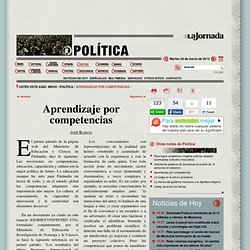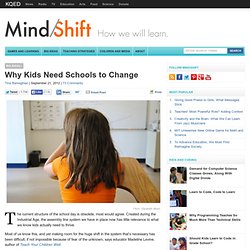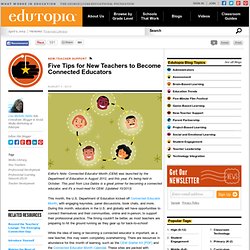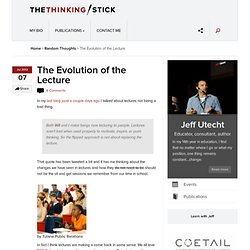

Patterns of Beliefs, Attitudes, and Characteristics of Teachers That Influence Computer Integration. Aprendizaje por competencias. L primer párrafo de la página web del Ministerio de Educación y Ciencia de Finlandia, dice lo siguiente: Las inversiones en competencias, educación, capacitación y cultura son la mejor política de futuro.

La educación siempre ha sido para Finlandia un factor de éxito, y en el mundo global las competencias adquieren una importancia aún mayor. La cultura, el conocimiento, la capacidad de innovación y la creatividad son elementos decisivos. En un documento ya citado en este espacio (ED/BIE/CONFINTED 47/4), formulado conjuntamente por el Ministerio de Educación e Investigación de Noruega y la Unesco, se hace la siguiente referencia en su primer párrafo: Los resultados del último Programa Internacional de Evaluación de Estudiantes (PISA) de la OCDE convirtieron a Finlandia en la Meca de los peregrinos de la educación, determinados a descubrir el secreto del éxito del sistema educativo finlandés. La noción de competencia tiene muchos significados.
Philosophy for children. National Girls Collaborative Project. Why Kids Need Schools to Change. Big Ideas Flickr: Elizabeth Albert The current structure of the school day is obsolete, most would agree.

Created during the Industrial Age, the assembly line system we have in place now has little relevance to what we know kids actually need to thrive. Most of us know this, and yet making room for the huge shift in the system that’s necessary has been difficult, if not impossible because of fear of the unknown, says educator Madeline Levine, author of Teach Your Children Well.
“People don’t like change, especially in times of great uncertainty,” she said. “I’m astounded at the glacial pace of change in education.” During this time of economic uncertainty, especially, Levine said parents want to make sure their kids won’t fall into the ranks of the unemployed and disenfranchised young people who return home because they’re unable to find jobs. Yet therein lies the paradox. “I’m astounded at the glacial pace of change in education,” she said. PROJECT BASED LEARNING. Family Diversity in the Classroom - Teaching Family Diversity. Family is the most basic element of self-identification for young children; it shapes and informs their sense of self and who they are in the world.

It is important for students to see their families reflected in the world around them, while at the same time seeing the diversity of families that also exists in our communities. Organize evening events to bring your school community together and involve more parents and guardians in your school. Show the award winning film, What Do You Know? To help parents and guardians develop language to talk with their children about gay and lesbian topics, such as families with two dads. La pedagogía del caracol: Por una escuela lenta y no violenta - Gianfranco Zavalloni. The Teacher’s Survival Kit for Lesson Planning! Tips & 1000s of Free Lesson Plans. Posted by Shelly Terrell on Saturday, August 18th 2012 Goal 16: Plan An Engaging Lesson of The 30 Goals Challenge for Educators I cannot teach anybody anything, I can only make them think. – Socrates Lesson planning is stressful and time-consuming, but is important in giving us an action plan for the entire school year.

The way we design our curriculums and the activities we use will determine how successful our learners will be in grasping new knowledge. Lesson design and planning is important. A Few Tips … The Book Whisperer. Five Tips for New Teachers to Become Connected Educators. Editor's Note: Connected Educator Month (CEM) was launched by the Department of Education in August 2012, and this year, it's being held in October.

This post from Lisa Dabbs is a great primer for becoming a connected educator, and it's a must-read for CEM. (Updated 10/2013) This month, the U.S. Department of Education kicked off Connected Educator Month, with engaging keynotes, panel discussions, book chats, and more. During this month, educators in the U.S. and globally will have opportunities to connect themselves and their communities, online and in-person, to support their professional practice. While the idea of being or becoming a connected educator is important, as a new teacher, this may seem completely overwhelming. Having said that, I'd like to chunk this Connected Educator Learning Month opportunity into five educator "Be-Attitudes" that might be easier for a new or pre-service teacher to embrace.
Be sure to read each one and give us some feedback. What is Web 2.0? Funny Daily Show Collection Of Clips On Education. The Evolution of the Lecture. In my last blog post a couple days ago I talked about lectures not being a bad thing.

Both Will and I make livings now lecturing to people. Lectures aren’t bad when used properly to motivate, inspire, or push thinking. So the flipped approach is not about replacing the lecture. That quote has been tweeted a bit and it has me thinking about the changes we have seen in lectures and how they do not need to be should not be the sit and get sessions we remember from our time in school. The 3 quotations I keep on my office wall.